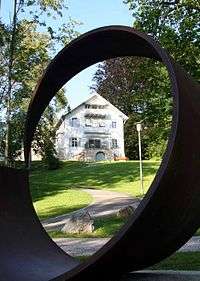Franz Marc Museum
The Franz Marc Museum is a museum located in Kochel am See, Upper Bavaria, dedicated to German Expressionist painter Franz Marc. The museum shows paintings by Franz Marc, and also works of art of his contemporaries and other important artists of the 20th century, in a permanent and in temporary exhibitions.[1][2]
.jpg)
History
The Franz Marc Museum is a private institution, which was founded in 1986 to present the life and work of Marc, one of the most important artists of Bavaria in the 20th century, in the place where he lived and which gave him so much inspiration.[3][4]

The museum exhibits 2000 works, including more than 150 works from the estate of Franz Marc, which are complemented with various loans. It also holds many of his personal items and written documents, as well works of art by some of his contemporary artists, such as Paul Klee, Wassily Kandinsky, Max Pechstein, Erich Heckel, Max Beckmann, Gabriele Münter and Alexej von Jawlensky. The exhibition illustrates the influence of Franz Marc and his colleagues of the Expressionist group Der Blaue Reiter in contemporary art.[5][6]
In 2008, a new building was inaugurated, having being designed by Swiss architects Diethelm & Spillmann, and it opened up new possibilities for the museum's conception. It extended the exhibition space by around 700 m2, so that Marc's work could be put in the context of the 20th century art. Especially after the addition to the Franz Marc Bequest and the Franz Marc Foundation of the collection of the Etta and Otto Stangl Foundation, it became possible to showcase the work of Marc with the some of his other contemporaries, such as from the artists from the other German Expressionist group Brücke, and also post-World War II German and French artists, like Joseph Beuys, Per Kirkeby and Georg Baselitz.[7]
The museum continuously changes the displays of the collection, which provides new insights about Marc's work and his influence in German contemporary art.[8]
On the occasion of the 100th anniversary of the artist's death, on 4 March 2016, the museum dedicated him an exhibition trilogy, under the collective title "Franz Marc - Between Utopia and Apocalypse" (Franz Marc – Zwischen Utopie und Apokalypse), each one called, respectively, "The Poor Country of Tirol", "Grazing Horses" and "Fighting Forms".[9] The museum also holds periodically exhibitions dedicated to contemporary artists. It inaugurated recently the exhibition "Blauer Reiter-Das Moment der Abstraktion", dedicated to the Blaue Reiter artists and how they paved the way to abstraccionism.[10]
The Franz Marc Museum is part of the MuSeen Landscape Expressionism (MuSeenLandschaft Expressionismus), in Germany, together with the Museum der Phantasie ("Buchheim Museum"), in Bernried am Starnberger See, the Museum Penzberg, the Schloßmuseum Murnau (Castle Museum Murnau), and the Municipal Gallery Lenbachhaus, in Munich.[11]
Friends of the Franz Marc Museum
The Friends of the Franz Marc Museum is an association that sponsors exhibitions on Franz Marc, artists of Der Blaue Reiter or Die Brücke, as well as on abstract art of the 20th century, especially German post-World War II art. Their commitment enables them to buy works of art to supplement the collections of the Franz Marc Museum. They also support the development of new placement services to promote understanding of art and to show their contexts and backgrounds. In addition, they facilitate series of talks, events and symposia, scientific conferences on 20th-century art and cultural history, and publications documenting these events or presenting new research results. They also promote cultural events such as readings or concerts and support placement services for non-educated sections of the population and young people.
Works
Some of the best known works of the museum are:[12]
- Franz Marc, Springendes Pferd, 1912
- Franz Marc, Kleine Komposition IV, 1914
- Franz Marc, Moorhütten im Dachauer Moor, 1902
- Franz Marc, Kleine Pferdestudie II, 1905
- Franz Marc, Zwei Frauen am Berg, 1906
- Franz Marc, Hocken im Schnee, 1911
- August Macke, Große Promenade, 1914
- Ernst Ludwig Kirchner, Zwei Tänzerinnen, 1910–11
- Willi Baumeister, Figur in absoluter Stellung, 1919
References
- Franz Marc Museum, Muenchen.De (German)
- Franz Marc Museum: Die Sammlung (German), Hirmer Verlag GmbH, Hardcover, 2019 SBN: 978-3-7774-3379-0
- Franz Marc Museum at Google Arts and Culture
- Das Franz Marc Museum in Kochel am See, Radio Bayern 2, 2 January 2018 (German)
- Franz Marc Museum, Muenchen.De (German)
- Wilde Kunst, wilde Natur - Das Franz Marc Museum in Kochel am See, ZDF Kultur, 23 September 2018 (German)
- Marc-Museum in Kochel - Eine Burg für Franz, Spiegel Online, 18 June 2008 (German)
- Das Franz-Marc-Museum in Kochel neu entdecken: Sammlungskatalog überarbeitet, Merkur.de, 18 June 2019 (German)
- Franz Marc Year 2016, franz-marc-museum.de, 25 February 2016 (German)
- Das Franz-Marc-Museum zeigt, wie der Blaue Reiter neue Formen fand, Süddeutsche Zeitung, 13 October 2019 (German)
- "MuSeenLandschaft Expressionismus".
- Franz Marc Museum: Die Sammlung (German), Hirmer Verlag GmbH, Hardcover, 2019 SBN: 978-3-7774-3379-0